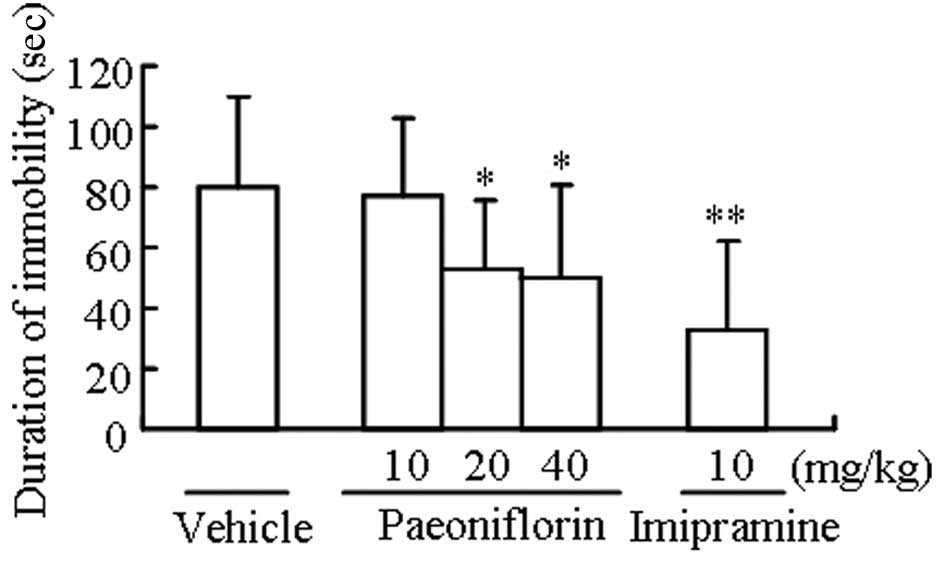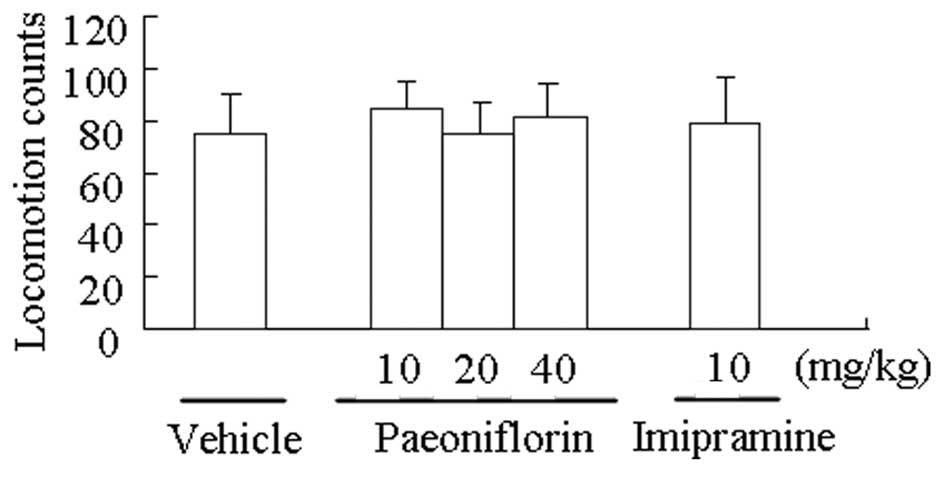|
1
|
Shen JW and Liang ZJ: Advances in research
on biological etiology of depression and the antidepressants.
Pharmaceut Care Res. 7:94–99. 2007.
|
|
2
|
Mandrioli R, Mercolini L, Saracino MA and
Raggi MA: Selective serotonin reuptake inhibitors (SSRIs):
therapeutic drug monitoring and pharmacological interactions. Curr
Med Chem. 19:1846–1863. 2012. View Article : Google Scholar : PubMed/NCBI
|
|
3
|
Park SW, Kim YK, Lee JG, Kim SH, Kim JM,
et al: Antidepressant-like effects of the traditional Chinese
medicine kami-shoyo-san in rats. Psychiatry Clin Neurosci.
61:401–406. 2007. View Article : Google Scholar : PubMed/NCBI
|
|
4
|
Huang Z, Mao QQ, Zhong XM, Li ZY, Qiu FM
and Ip SP: Mechanistic study on the antidepressant-like effect of
danggui-shaoyao-san, a chinese herbal formula. Evid Based
Complement Alternat Med. 2012:1735652012. View Article : Google Scholar : PubMed/NCBI
|
|
5
|
Xie ZL and Wang XH: Clinical study of
Jiawei Sini Decoction in the treatment of 38 dysthymic patients.
Chin J Inf TCM. 12:8–9. 2005.
|
|
6
|
Mao QQ, Ip SP, Ko KM, Tsai SH, Xian YF and
Che CT: Effects of peony glycosides on mice exposed to chronic
unpredictable stress: further evidence for antidepressant-like
activity. J Ethnopharmacol. 124:316–320. 2009. View Article : Google Scholar : PubMed/NCBI
|
|
7
|
Ye J, Duan H, Yang X, Yan W and Zheng X:
Anti-thrombosis effect of paeoniflorin: evaluated in a
photochemical reaction thrombosis model in vivo. Planta Med.
67:766–767. 2001. View Article : Google Scholar : PubMed/NCBI
|
|
8
|
Xiao L, Wang YZ, Liu J, Luo XT, Ye Y and
Zhu XZ: Effects of paeoniflorin on the cerebral infarction,
behavioral and cognitive impairments at the chronic stage of
transient middle cerebral artery occlusion in rats. Life Sci.
78:413–420. 2005. View Article : Google Scholar : PubMed/NCBI
|
|
9
|
Zhong SZ, Ge QH, Li Q, Qu R and Ma SP:
Peoniflorin attenuates Abeta(1-42)-mediated neurotoxicity by
regulating calcium homeostasis and ameliorating oxidative stress in
hippocampus of rats. J Neurol Sci. 280:71–78. 2009. View Article : Google Scholar
|
|
10
|
Mao QQ, Huang Z, Ip SP and Che CT:
Antidepressant-like effect of ethanol extract from Paeonia
lactiflora in mice. Phytother Res. 22:1496–1499. 2008.
View Article : Google Scholar : PubMed/NCBI
|
|
11
|
Mao QQ, Ip SP, Ko KM, Tsai SH, Zhao M and
Che CT: Peony glycosides protect against corticosterone-induced
neurotoxicity in PC12 cells. Cell Mol Neurobiol. 29:643–647. 2009.
View Article : Google Scholar : PubMed/NCBI
|
|
12
|
Mao QQ, Xian YF, Ip SP, Tsai SH and Che
CT: Protective effects of peony glycosides against
corticosterone-induced cell death in PC12 cells through antioxidant
action. J Ethnopharmacol. 133:1121–1125. 2011. View Article : Google Scholar : PubMed/NCBI
|
|
13
|
Mao QQ, Zhong XM, Qiu FM, Li ZY and Huang
Z: Protective effects of paeoniflorin against
corticosterone-induced neurotoxicity in PC12 cells. Phytother Res.
26:969–973. 2012. View
Article : Google Scholar : PubMed/NCBI
|
|
14
|
Mao QQ, Ip SP, Xian YF, Hu Z and Che CT:
Anti-depressant-like effect of peony: a mini-review. Pharm Biol.
50:72–77. 2012. View Article : Google Scholar : PubMed/NCBI
|
|
15
|
Steru L, Chermat R, Thierry B and Simon P:
The tail suspension test: a new method for screening
antidepressants in mice. Psychopharmacology (Berl). 85:367–370.
1985. View Article : Google Scholar : PubMed/NCBI
|
|
16
|
Yin C, Gou L, Liu Y, Yin X, Zhang L, Jia G
and Zhuang X: Antidepressant-like effects of L-theanine in the
forced swim and tail suspension tests in mice. Phytother Res.
25:1636–1639. 2011. View
Article : Google Scholar : PubMed/NCBI
|
|
17
|
Sánchez-Mateo CC, Bonkanka CX, Prado B and
Rabanal RM: Antidepressant activity of some Hypericum
reflexum L. fil. extracts in the forced swimming test in mice.
J Ethnopharmacol. 112:115–121. 2007.
|
|
18
|
Porsolt RD, Bertin A and Jalfre M:
Behavioral despair in mice: a primary screening test for
antidepressants. Arch Int Pharmacodyn Ther. 229:327–336.
1977.PubMed/NCBI
|
|
19
|
Nesterova YV, Povetieva TN, Suslov NI,
Semenov AA and Pushkarskiy SV: Antidepressant activity of diterpene
alkaloids of Aconitum baicalense Turcz. Bull Exp Biol Med.
151:425–428. 2011. View Article : Google Scholar : PubMed/NCBI
|
|
20
|
Bourin M, Poncelet M, Chermat R and Simon
P: The value of the reserpine test in psychopharmacology.
Arzneimittelforschung. 33:1173–1176. 1983.PubMed/NCBI
|
|
21
|
Bourin M, Fiocco AJ and Clenet F: How
valuable are animal models in defining antidepressant activity? Hum
Psychopharmacol. 16:9–21. 2001. View
Article : Google Scholar : PubMed/NCBI
|
|
22
|
Mao QQ and Huang Z: Antidepressant drugs
and animal models of depression. Foreign Med Sci. 32:216–220.
2005.
|
|
23
|
Dhingra D and Sharma A:
Antidepressant-like activity of Glycyrrhiza glabra L. in
mouse models of immobility tests. Prog Neuropsychopharmacol Biol
Psychiatry. 30:449–454. 2006.
|













